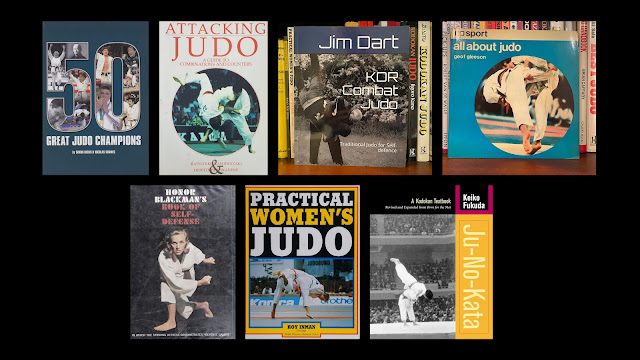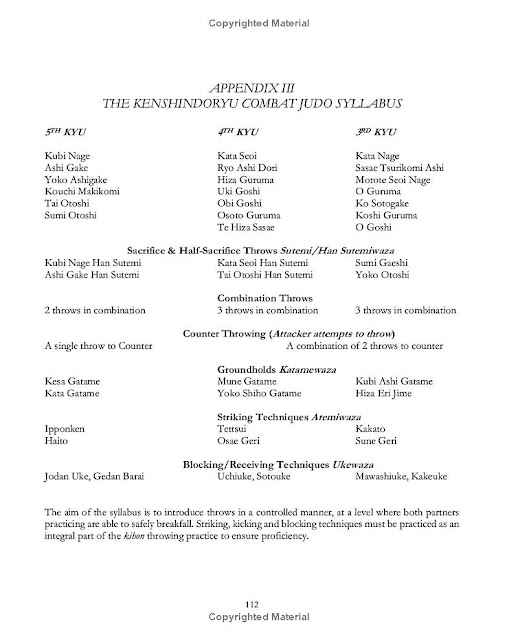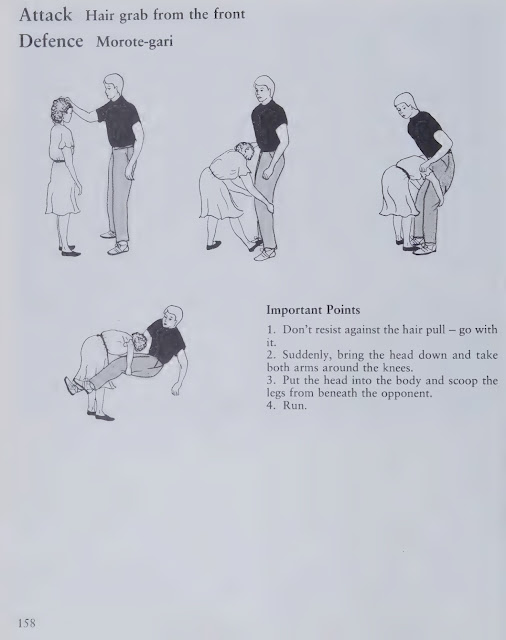May 2023 Book Survey Part 3
Welcome to the May 2023 book survey, part three. I decided to break this month's survey into three posts. The themes for this month are judo, judo, and more judo! Here is part one and here is part two.
Introduction
In May 2023, I (Richard) continued my book survey plan. This post examines 7 books on judo, featuring three about or for women.
50 Great Judo Champions, Simon Hicks, Nicolas Soames, 2001
I bought my copy of 50 Great Judo Champions directly from the publisher. Hicks is cofounder of Fighting Films and Soames is founder of Ippon Books. My copy of their book is a hardcover measuring 7 3/4 inches by 10 1/2 inches with 118 pages. Pages 1-86 are black and white while 87 to 118 are in color.
This is a pretty neat book. It celebrates the founding of the International Judo Federation in 1951. I wondered if they might produce another edition in 2026 for the 75th anniversary?
For each of the 50 champions, the authors offer a multipage biography with key stats and pictures. I liked this format and learned a lot about each competitor.
Attacking Judo: A Guide to Combinations and Counters, Katsuhiko Kashiwazaki, Hidetoshi Nakanishi, Sarah Cousens, 1995
I believe I also bought my copy of Attacking Judo : A Guide to Combinations and Counters directly from the publisher, but I can't find a record of it and it doesn't seem to be for sale on the Fighting Films site anymore. My copy is a 2006 reprint. It measures 6 3/4 inches by 9 1/2 inches, with 136 black and white pages. There is a home-scanned copy available at the Internet Archive.
This book starts with coverage of 15 throws and the concludes with 40 pages of Katame-Waza (holding techniques). I liked the clear, clean drawings linked to each other, and the occasional competition photo. Here are a few excerpts from the digital copy:
Overall, I like this book, but the price on the secondary market will put physical copies out of reach for some readers.
KDR Combat Judo: Traditional Judo for Self-Defence, Jim Dart, 2020
I bought a copy of KDR Combat Judo because I am curious about the martial aspect of judo. This flavor is tough to find in most places these days. My copy of this book is a paperback measuring 7 1/2 inches by 9 1/4 inches with 116 black and white pages. It is a print on demand book.
"KDR" stands for Kenshin Do Ryu, apparently derived from "Zen Judo"? The book begins with the following quote to establish its tone:
"[Judo] is the study of techniques with which you may kill if you wish to kill, injure if you wish to injure, subdue if you wish to subdue, and, when attacked, defend yourself."
It is attributed to Jigoro Kano, founder of Judo. I could only find one source for this supposed quote -- the 1983 book Judo Formal Techniques by Donn F. Draeger and Tadao Otaki:
As you can see, the authors cite "1889" as their source. I assume they are referring to Jiujutsu (柔術) The Old Samurai Art of Fighting Without Weapons, by Rev. T. Lindsay and J. Kano, published in 1889, and which I covered previously as Beware Your Sources: A Brief Look at Kano Jigoro's Paper on Jiujutsu and Jiudo-Judo. That quote, and nothing like it, appears in the paper.
I have a feeling Draeger and Otaki were loose with their "scholarship," as we know from my previous post June 2021 Book Survey: Budo and Associated Topics Part 1 that Draeger described modern arts in his third title Modern Bujutsu and Budo as "perverted practices" (p 64) and "little of lasting value" (p 179). For a judoka like him, inventing a quote by Kano that showed judo was for killing would be a way to square his practice with his worldview.
Thankfully, the KDR book did not spiral downwards from this beginning quote. In fact, I was pleasantly surprised by its presentation and content. Here is a sample page:
The photos are small but usually clear enough. I wish they had not shown two training partners in white gis on a light background and light mats, however.
I liked the inclusion of Japanese and English technique names. It was interesting seeing the style incorporate striking and "pressure point application."
The bulk of the book (chapters 2-7) provide the KDR style syllabus from 5th kyu to 1st dan. I thought this was excellent. Here is a summary:
So often I see new judo students asking what they must do to advance in rank, and this chart answers that question for the KDR system.
Overall, I liked this book and I encourage others to share how they approach learning and curricula in judo.
All about Judo, Geof Gleeson, 1975
I bought a copy of All about Judo because it seemed to sit in a transition period, during the early days of Olympic competition (1975). My copy is a paperback measuring 7 7/8 inches by 7 7/8 inches, with 144 black and white pages. It's part of a larger series on sports, which makes it even weirder.
This book's content are all over the place. One section is titled "ritual, myth, and magic." What?! About 40 pages, about 28% of the book, are devoted to kata.
This book is probably worth a look for the kata alone, as it is undercovered in most judo books. I have to take a second look at the ritual, myth and magic part.
Honor Blackman's Book of Self Defense, Honor Blackman, Joe Robinson, Doug Robinson, 1966
I bought a copy of Honor Blackman's Book of Self-Defense shortly after the actress passed away. She lived from 1925 to 2020, and I knew her primarily from the James Bond movie Goldfinger, where I recalled her throwing Sean Connery.
My copy is a hardcover with a 1966 date. There's also a 1965 version.
My copy is a hardcover measuring 6 5/8 inches by 9 5/8 inches with 128 black and white pages. The same edition is available at the Internet Archive.
Right away I noticed the "metadata" for this book was fixated on Honor's looks. It starts on the bottom of the cover:
It continues with the overleaf:
It was nice to see this book pitched at men and women though.
Thankfully, once we get to the content actually by Honor, it is pretty straightforward. I was not happy to see her claim that judo's "original form... was invented by Lama monks in ancient China" (p 12). See this post for more on that myth.
The first part of the book shows traditional judo techniques with Honor wearing the gi. For example:
The gi section also shows some karate techniques:
The second part shows self defense in the street with realistic scenarios. For example:
The samples really do not do these photos by Brian Worth justice. They are much clearer and better in the print copy.
There is a neat article about the book published by Flashbak.
I really like this book. It captures a time when judo was probably at the height of its cultural popularity, right before Bruce Lee took the world by storm. RIP Honor Blackman.
Practical Women's Judo, Roy Inman, 1989
A bit more than 20 years later, we have Practical Women's Judo, originally published in 1987 as Judo for Women. The author was the British Women's Judo National Coach. My copy of this book is a paperback measuring 7 3/8 inches by 9 5/8 inches with 176 black and white pages. You can find it at the Internet Archive.
The book consists of advice, throws, newaza, and self-defense -- like using a double leg to counter a hair grab!
I think that advice needs to be tested, but I think it's funny that someone who tries a hair grab would get double-legged! Take that fool to the ground!
This book is a nice mix of gym and competition photos, plus decent drawings. Again, notice how a book about judo, as late as 1989, includes self defense components.
Ju-No-Kata: A Kodokan Textbook, Keiko Fukuda, 2004
My copy of Ju-No-Kata: A Kodokan Textbook is a paperback measuring 8 inches by 10 inches, with 176 black and white pages. This 2004 edition is expanded from the original version titled Born for the Mat, published in 1973.
The 2004 version is on the Internet Archive.
Keiko Fukuda (1913-2013) originally trained in the official women's judo program at the Kodokan, taught by founder Jigoro Kano. Her grandfather, Fukuda Hachinosuke (d. 1880) was Kano's first real jujutsu teacher, for the art of Tenshin Shinyo Ryu. She trained with Kano from 1935 until his death in 1938.
This book covers a judo kata designed specifically for women. The book is a mix of the older, grainy photos from the 1973 version, and updated material from 2004.
The Internet Archive scan has blurry photos, but these give you an idea of the presentation.
I think this is another interesting capture of an aspect of judo lost in the modern world of competition.
Conclusion
I liked a lot of the books in this post. My favorite is the work by Honor Blackman. My surprise to the upside was the KDR title.
In the next post we will turn to our June survey titles.
You may know about our Amazon Wish List. If you would like to help us get books to read and review from that list, then please consider supporting us via Buy Me a Coffee.
If you like this article, check out our Facebook page, Instagram account, Twitter feed, and Amazon Wish List. Be devoted!






























Comments
Post a Comment